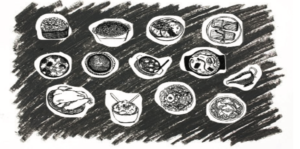At a time when our political climate is turbulent, my current status reminds me of my limitation as an immigrant in this country. Currently, I find myself thinking about the process to become a U.S. citizen, yet unfortunately, I did not qualify in time for this election. As an art history and studio art major, I constantly find myself analyzing both my past and present as an artist. In the “Asian Art Today” class, I found myself relating to some of the artists whose work reflect their personal endeavors on immigration.
On Thursday, Oct. 20, Margo Machida, Ph.D, professor in art history and Asian American studies at the University of Connecticut, gave a lecture titled Trans-Pacific Visions: Islands and Oceanic Imaginaries in Asian American Art. With each of the artists’ works that Dr. Machida selected for this lecture, the viewer could feel the daunting question of identity. Machida is third generation Asian-American, and yet her identity lies in two categories. In her essay ”Asian Identities in America,” Dr. Machida writes that growing up in Hawaii she did not find herself questioning her identity; it was not until she arrived to the Mainland that the question of who she was became visible to her.
Dr. Machida correlates her research to the identities of other Asian American artists and to my surprise, it extends to Latin-Asian-Americans. For the most part, many of the artists in her research linked their transcultural themes to ancestral origins, intercultural transcendence, unsettled identity issues and a feeling of otherness that they expressed throughout their work. These are easily identifiable themes for those descendants of immigrants or recently immigrated.
But the most powerful thing I heard during that night was when I asked Dr. Machida if it is the U.S. that makes us question who we are. Why is it that everyone except “whites” have to label themselves as “Mexican-Americans” or from whatever other culture we come from? Even though, as in Dr. Machida’s case, she has to identify as a third generation American, but must say “Asian-American.” She told me that she wants to label herself Asian-American, to not forget where her family comes from and to honor her culture. It is not the label, but the negative implication that comes with it. I realized then that she was right! Questioning my identity does not come from the fact that I am Mexican, but that it makes me different. In my case people are guessing where I am from and are usually surprised when I say Mexico because I don’t fit their idea of what a Mexican looks like.
Which brings me to the following acknowledgement: California and other states belonged to Mexico, and if we get technical, Mexico is part of the continent of America. Furthermore, it is a part of North America just as the U.S. is.
I left this lecture considering my identity. Where do I fall in the spectrum of Americanness? When I have lived here most of my life, when I have been nourished in this very city of Oakland, when America is an entire continent that has a north, a central and a south, where is it that I stand, my dear America? Today, I find myself filling out forms to become a citizen in a country that in my heart is mine, too. How is it, that I am the immigrant when my family migrated from within the same continent and those who claim my home to be theirs came from across the ocean?


